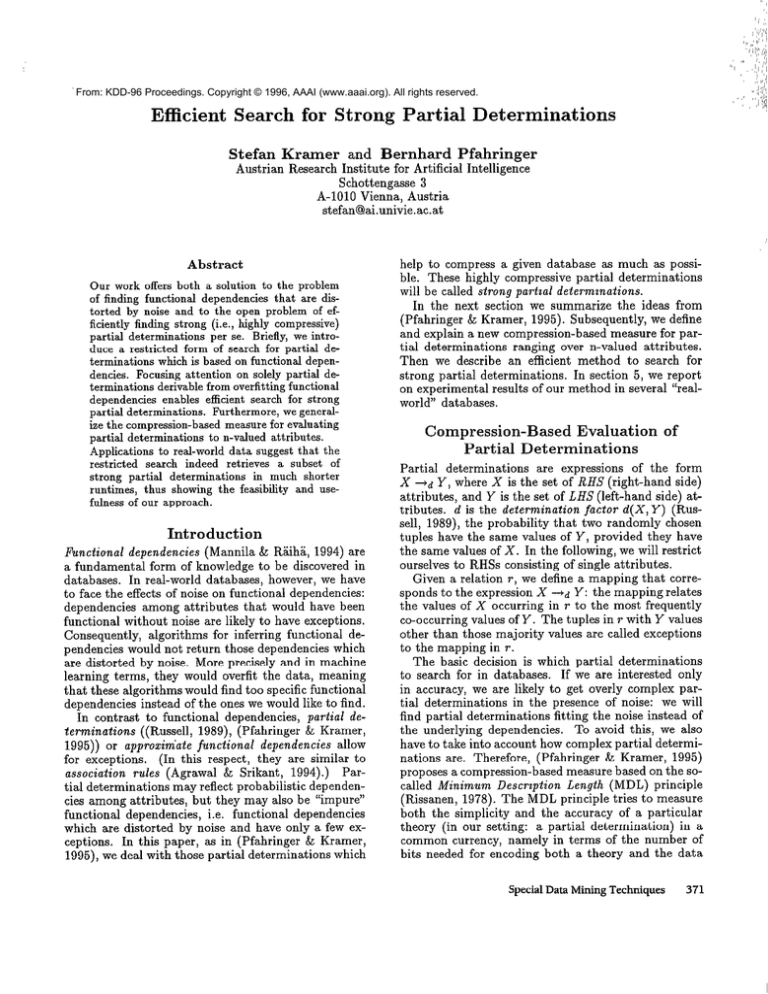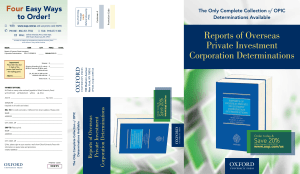
From: KDD-96 Proceedings. Copyright © 1996, AAAI (www.aaai.org). All rights reserved.
Efficient
Search for Strong
Partial
Determinations
St&n
Kramux
md -Bernhard
-- -----_- - Pfahrinmx
Austrian Research Institute for Artificial Intelligence
Schottengasse 3
A-1010 Vienna, Austria
stefan@ai.univie.ac.at
Abstract
Our work offers both a solution to the problem
of finding functional dependencies that are distorted by noise and to the open problem of efficiently finding strong (i.e., highly compressive)
partial determinations
per se. Briefly, we introduce a restricted form of search for partial determinations which is based on functional dependencies. Focusing attention on solely partial determinations derivable from overfitting functional
dependencies enables efficient search for strong
partial determinations.
Furthermore, we generalize the compression-based measure for evaluating
partial determinations to n-valued attributes.
Applications to real-world data suggest that the
restricted search indeed retrieves a subset of
strong partid determinations
in much shorter
runtimes, thus showing the feasibility and usefulness of our approach.
Introduction
Functional dependencies (Mannila & Raiha, 1994) are
a fundamental form of knowledge to be discovered in
databases. In real-world databases, however, we have
to face the effects of noise on functional dependencies:
dependencies among attributes that would have been
functional without noise are likely to have exceptions.
r-i---I__^ -.LL. alg”rlbMm
-I---:LL-.f-..
I”1 :,c,...,:,,.
Illlt;lllll~ c..,,+:,,,,
IuI,LbI”I,a, ,.l,
UC?
~“ILsaquarlbly,
pendencies would not return those dependencies which
are distorted by noise. More precisely and in machine
learning terms, they would overfit the data, meaning
that these algorithms would find too specific functional
dependencies instead of the ones we would like to find.
In contrast to functional dependencies, partial determinations ((Russell, 1989), (Pfahringer & Kramer,
1995)) or approxiniate functional dependencies allow
for exceptions. (In this respect, they are similar to
association rules (Agrawal & Srikant, 1994).) Partial determinations may reflect probabilistic dependencies among attributes, but they may also be “impure”
functional dependencies, i.e. functional dependencies
which are distorted by noise and have only a few exceptions. In this paper, as in (Pfahringer & Kramer,
1995), we deal with those partial determinations which
help to compress a given database as much as possible. These highly compressive partial determinations
will be called strong partaal determanations.
In the next section we summarize the ideas from
/XT,., .
n TJ
.rrnr\ n 1
(rranrmger dl; nramer, luvoj. >uosequentiy, we define
and explain a new compression-based measure for partial determinations ranging over n-valued attributes.
Then we describe an efficient method to search for
strong partial determinations. In section 5, we report
on experimental results of our method in several “realworld” databases.
Compression-Based
Evaluation
Partial Determinations
of
Partial determinations are expressions of the form
X -fd Y, where X is the set of RHS (right-hand side)
attributes, and Y is the set of LHS (left-hand side) attributes. d is the determination factor d(X, Y) (Russell, 1989), the probability that two randomly chosen
tuples have the same values of Y, provided they have
the same values of X. In the following, we will restrict
ourselves to RHSs consisting of single attributes.
Given a relation r, we define a mapping that corresponds to the expression X +d Y: the mapping relates
the values of X occurring in r to the most frequently
co-occurring values of Y. The tuples in r with Y values
,.cL,..
“Llllrji
tL,m
bllcul
+h,on
“II”D.2
mc.;,,;t,,
ulaJ”vr,“y
~,.,l..na
“UIUG;Iu
.,,.n
ChIti
s.nl1or-l
.dc&IIbU
.avom,t;T\*Ia
h-.““~“A”IIY
to the mapping in r.
The basic decision is which partial determinations
to search for in databases. If we are interested only
in accuracy, we are likely to get overly complex partial determinations in the presence of noise: we will
find partial determinations fitting the noise instead of
the underlying dependencies. To avoid this, we also
have to take into account how complex partial determinations are. Therefore, (Pfahringer & Kramer, 1995)
proposes a compression-based measure based on the socalled Minimum Descraption Length (MDL) principle
(Rissanen, 1978). The MDL principle tries to measure
both the simplicity and the accuracy of a particular
theory (in our setting: a partial determination)
in a
common currency, namely in terms of the number of
bits needed for encoding both a theory and the data
Special Data Mining Techniques
371
%aw~’ Data of Database
---c Receiver
Sender -
Compressed Database
V
x
W
-
Sender -c
Maw&z
f-l-7
+ m
Receiver
Exceptions
Figure 1: Transmission metaphor.
given that theory. The theory with the mznimal total
message length (the most compressive partial determination) is also the most probable theory explaining the
data (Rissanen, 1978).
To illustrate the key idea of the measure for partial determinations proposed in (Pfahringer & Kramer,
1995)) we consider the hypothetical task of transmitting a given database as efficiently as possible (see
fig. 1). If we can find a good partial determination
X -fd Y for a given attribute Y, transmitting the partial determination instead of the raw data may improve
efficiency considerably: we just have to transmit the
mapping (the model) and transmit the information to
correct the values of Y for the exceptions to the mapping. Thus, we have to identify the exceptions (the
“grey tuples” in figure 1) and transmit the corrections
(the black box in figure 1). The values of Y need not
be transmitted anymore. Thus we achieve some compression of the data, the degree of which is estimated
by our measure based on the MDL principle.
The work reported in (Pfahringer & Kramer, 1995)
has several limitations and problems: the paper only
deals with partial determinations ranging over boolean
attributes.
Secondly, the problem of efficiently finding compressive partial determinations has not been
solved. Thirdly, the method has not yet been applied
to real-world databases. The following sections present
extensions of our work that overcome these problems
and limitations.
A New Compression-Based
Measure for
Multi-Valued
Partial Determinations
In figure 2? we define the new compression-based measure for partial determinations ranging over multivalued attributes. The total coding length (1) is the
sum of the coding length of the mapping and the coding length of the corrections to be made. The coding
length for a mapping (2) is the sum of the coding length
372
Technology Spotlight
for specifying the LHS-attributes and of the coding
length for the string of values for the RHS-attribute.
The alphabet for this string is the domain of the RHSattribute.
Exceptions to the mapping are encoded by (3). We
have to identify the exceptions, and additionally encode a string of corrections for the identified exceptions
to the mapping. Again, the aiphabet of this string is
the domain of the RHS-attribute.
The entropy-based bound of (Shannon & Weaver,
1949) is used as an estimate for the cost cchooseof encoding the selection of E elements out of N possible
elements (4). Encoding a string over a multi-valued
alphabet (5) is a straightforward generalization of (4).
It can be thought of as a repeated binary selection encoding of what is the value occurring most frequently
and which positions in the string are exceptions, i.e.
have a different value. The resulting formula can be
simplified to the definition (5) for c.+,i,,
““, y,yy;which is just
the sum of the entropy of the distribution of values in
the string (6) and of an encoding of the values’ identities sorted according to their frequencies (a kind of
codebook for the particular string, 7).
Efficient
Search for Strong
Determinations
Partial
Based on the view of partial determinations as functional dependencies which are distorted by noise, we
propose an efficient search strategy to find strong parting
J&E.
gy&tsing
f~nctial det4erminat*ions. St
L 2a.I&+.
tional dependencies, we propose to search for the best
subset of left-hand side attributes according to our
MDL-measure which avoids fitting the noise. In machine learning terminology again, we propose to prune
the left-hand sides of overfitting functional dependencies. Pruning is achieved by a complete A*-like search
over all subsets of LHS-attributes of the original functional dependency. In the following, we will refer to
this two-level approach as restricted search. Limiting
our attention to this highly interesting subset of partial
determinations enables efficient search.
Even though both searching for functional dependencies and for partial determinations is exponential
in the worst case, on average functional dependencies
can be searched for much more efficiently due to much
stronger pruning criteria. Additionally the evaluation
function is much simpler: just counting the number
of tuples in a projection vs. creating a mapping and
computing its coding length for a projection. So in restricted search the expensive part has only to deal with
a small number of attributes, namely those occurring
in the left-hand side of the respective functional dependency,
Furthermore,
as
a
flunctinna!
depm!ency
is
a partial determination with no exception, it also supplies an upper-bound on the coding length of possibly
better partial determinations in the restricted search.
The next section will empirically show the effectiveness of restricted search in comparison to full search.
c(PD)
=
c(Mupping)
c( Mapping)
c(Ezceptions)
=
=
c,~,,,,(lUsedAttrsl,
c,h,o,,(lEZcePtionsI,
moose (E, N)
cstring(St~iw)
=
=
N * entropy({E, N - E})
Zength(String) * entropy(char-frequencies(String))
=
-(f’plog(F,lN)),where
N = 5 F,
entropy({Fr,...,FM})
+ c(Ezceptions)
(1)
IAZIAttrsl) + cst,.ans(RHS Values Mapping)
IAIIEzamplesl) + c,t,.&Cowections)
(2)
(3)
(4)
+ c,ar2Le-OTder(String) (5)
(6)
i=l
t=l
j-l
1 g il.4 -) i ,where M is the cardinality of the alphabet,
i=o
and j is the number of different chars in String.
cot
0
P * logz( P)
(7)
if P=O
otherwise
Figure 2: The definition of the coding length c of a partial determination.
Full search is implemented as an iterative-deepening
best-first search for partial determinations. For pragmatic reasons, if the number of attributes is larger than
20, both search approaches must be iimited,to iefthand sides of a prespecified maximum length, which is
usually 10 in our experiments.
Empirical
Results
For a preliminary empirical comparison of both search
strategies we have done experiments using various
small to medium-sized “real-world” databases. Breast
cancer, Lymphography,
and Mushroom are taken
from the UCI-repository.
Peace, Conflicts,
and
Attempts are databases capturing mediation attempts
iii
iiitf3YiZtiC3d
COi&CtS
&Ed
CliSt3
\/l-L?,nnl
~rcbyp~
ot
LU
a!.,
1996). Table 1 gives the sizes (number of attributes
and number of tuples) of these databases and summarizes the search results. For the restricted search approach (pruning of overfitting functional dependencies)
we list the number of attributes, for which a partial
determination was found and the determinations’ average compression factor. This compression factor for
a given attribute is defined as the ratio between the
coding length of the raw data and the coding length of
the respective partial determination. Next we list the
average compression factor achieved by a full search
for partial determinations for the same RHS-attributes
as those for which the restricted search found compressive partial determinations,
Additionally we list
the number of attributes for which only the full search
was able to find compressive partial determinations,
and again include their average compression factor.
We can summarize as follows: for a subset of all attributes restricted search seems to find partial determinations which are on average almost as strong or
compressive as those found by full search. Partial determinations missed by restricted search are on av,.,.c.,..n
cxcltjr;
o:nm.;G:rantlrr
ul~jrrrrl~oruury
Tx,.albm
1”L.uIILbI
/with
\ “.I”II
thn
ovrmtinn
“&A” “~uuyv.v.I
nf t.ho
VI
YllV
Conflicts
database). We have not yet performed detailed runtime measurements, but even for the smallest database Breast Cancer the difference is already
of two orders of magnitude (SO seconds vs.
‘~ ~~~’
~~ ’I nourl.
For the other domains the differences in the runtimes
were even more drastic. Summing up, the restricted
search indeed retrieves a subset of strong partial determinations in much shorter runtimes.
Inspecting the retrieved determinations for useful
knowledge also provided a few insights. For instance
the peace database includes both a few raw numerical
attributes and their respective discretizations. Clearly
a discretization should be functionally dependent on
the raw data, which was not the case in the actual
database. These erroneous discretizations were discovered as partial determinations.
Moreover, we found
strong partial determinations reflecting the implicit
structure of the database: originally structured knowledge had been converted into one large and flat table
due to restrictions imposed by standard propositional
machine learning algorithms.
Related
Work
(Shen, 1991) describes an algorithm that searches for
determinations and two other kinds of regularities in
a large knowledge base. Since the algorithm is just
looking for determinations having a single left-hand
side attribute, there is no need to avoid overfitting the
data.
(Schlimmer, 1993) proposes an algorithm that returns every “reliable” partial determination with a
complexity lower than a user-defined threshold. Since
the evaluation function does not have a penalty for
overly complex dependencies, it does not avoid overfitting
(Russell, 1989) and (Kivinen & Mannila, 1995) propose to determine the accuracy of partial determinations (rpsppct;jyp!y -==---‘
2nnmuimn.t.e
--‘-‘- I- function&] &pen&nSpecial Data Mining Techniques
373
,’ ‘/I
(,‘<I
Domain
’ # A.
Br. Cancer
Lymph.
Mushroom
Peace
Conflicts
Attemots
11
19
23
50
33
17
# T. ’ B.estr.Search
# PDs
699
148
8124
1753
268
1753
Restr.Search
Compression
fi (4
6
1.49 (0.78)
14
7
33
24
10
1.13 (0.09)
95.16 (26.84)
4.47 (2.76)
1.38 (0.47)
2.23 (1.00)
Full Search
FuII Search
Compression
P (4
# Add.
PDs
1.64 (0.73)
1.13 (0.09)
100.03 (23.25)
4.63 (2.70)
1.38 (0.47)
2.26 (0.99)
5
5
15
16
4
7
Full Search
Ada. PDF
Compression
1.20
1.01
5.49
2.11
1.37
1.65
(0.07)
(0.01)
(6.32)
(0.85)
(0.24)
10.48)
Table 1: Results in real-world domains: the meaning of columns is explained in section 5.
ties) through sampling. However, if the proposed measures of accuracy would be used in a search framework,
the returned determinations would overfit the data.
Conclusion
and Further
Work
Our contribution is twofold: firstly, we offer a solution
to the problem of finding functional dependencies that
are distorted by noise. Secondly, we propose a solution to the open problem of efficiently finding strong
(i.e., highly compressive) partial determinations.
Focusing attention on partial determinations derivable
from overfitting functional dependencies enables etlicient search for strong partial determinations.
Furthermore, we have generalize the compressionbased measure for evaluating partial determinations to
n-valued attributes.
Applications to real-world data
suggest that the restricted search indeed retrieves a
subset of strong partial determinations in much shorter
runtimes, thus showing the feasibility and usefulness of
our approach.
Our approach to searching for partial determinations
hat
AA-” ~~vm.1
““I “I -1 limit.at.inne.
IIII.IVUIYAVA.Y. rlmrlv
y-y-- -.I 9 we cznp&
find
n!! pr-
tial determinations, but only a subset. However, experiments indicate that those partial determinations
which are distorted functional dependencies are among
the most compressive dependencies to be found. It is
also important to note that this approach is based on
assumptions about real-world data, namely that there
are strict functional dependencies which are distorted
by noise. Thirdly, if the noise level is too high, no
functional dependency might exist at all. So the pruning approach would not find partial determinations in
these situations.
We plan to extend our work along the following lines:
our method could be used to restructure the database
in order to minimize the required memory, similar to
INDEX (Flach, 1993). Another application of the measure could be to distinguish between reliable functional
dependencies and those which are due to chance. Finally, it would be interesting to compare and combine
our approach with sampling techniques as proposed in
(Kivinen & Mannila, 1995).
Acknowledgements
sored by the Austrian
This research is partly
spon-
Fonds zur Fbkderung
der Wis..~ .L ..LII:-L -.- lx .___1.. .._ - /z-T.T7D\ ..-J---..-A -..-L....
uuutx
&;1611C
IIUIIL”C:I
SenscnaJctzcnen ror.Ycrsurq
[r ““I-/
374
Technology Spotlight
P10489-MAT. Financial support for the Austrian Resedrch
Institute for Artificial Intelligence is provided by the Ai.&‘? s
trian Federal Ministry of Science, Trans$ort atid the Arts,:
’
Both the lymphography and the breast cancer domain’%!%,,
obtained from the University Medical ,Centre, Institute bpqi
Oncology, Ljubljana, Slovenia. The mediation databases
were obtained from the Department of Political Science at
the University of Canterbury, Christchurch, N.Z. We w&Id
like to thank M. Zwitter, M. SokIic and J. Bercovitch for
providing the data, and Gerhard Widmer for valuable discussions.
References
Agrawal R. and Srikant R.: Fast Algorithms for Mining
Association Rules. Proceedings of the 20th VLDB Conference, Santiago, Chile, 1994.
Flach P.A.: Predicate Invention in Inductive Data Engineering, in Brazdil P.B.(ed.), Machine Learning: ECML93, Springer, Berlin, pp.83-94, 1993.
Kivinen J., ManniIa H.: Approximate
dependency inference from relations,
Theoretzcal Computer
Science,
149(1):129-149, 1995.
ManniIa H. and R;iihi K.-J.: Algorithms for Inferring
n..m,4~~m-.i
n,,,,,r,,,:,,
~),i,+:,-L=, ,.*.*- I
I UI,L”,“I,a.l ~G~r;,,Ur;U~,r;U
Lpm,.,
‘“LU Lb~;Ia.~I”‘LD.
Data v#?AI1,‘“ul‘
edge Engeneering 12 (1994) 83-99, 1994.
Pfahringer B., Kramer S.: Compression-Based Evaluation
of Partial Determinations,
Proceedings of the First International Conference on Knowledge Discovery and Data
Minzng, AAAI Press, 1995.
J. Rissanen: Modeling by Shortest Data Description. In:
Automatica, 14:465-471, 1978.
Russell S.J.: The Use of Icnowledge in Analogy and Induction. Pitman Publishing, London, 1989.
Schlimmer J.C.: Efficiently Inducing Determinations:
A
Complete and Systematic Search Algorithm that Uses OpContimal Pruning. Proceedzngs of the lot” International
ference on Machine Learnzng, 1993.
Shannon C.E. and Weaver W.: The Mathematical Theory
University of Bhnois Press, 1949.
of Communication,
Shen W.-M.: Discovering Regularities from Large Knowledge Bases. Proceedings of the Sth International
Workshop
on Machine Learning, 1991.
Trappl R., Fiirnkranz J. and Petrak J.: Digging for Peace:
Using Machine Learning Methods for Assessing International Conflict Databases. Proceedings of the 12th European Conference on Artificial
Intelligence
(ECAI-96),
pp.
453-457, 1996.
r .,*






